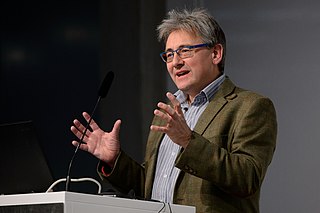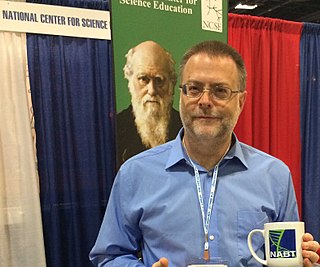Boldness is the opposite of shyness. To be bold implies a willingness to get things done despite risks. Boldness may be a property that only certain individuals are able to display.
Windows-1251 is an 8-bit character encoding, designed to cover languages that use the Cyrillic script such as Russian, Ukrainian, Belarusian, Bulgarian, Serbian Cyrillic, Macedonian and other languages.

Biological dispersal refers to both the movement of individuals from their birth site to their breeding site, as well as the movement from one breeding site to another . Dispersal is also used to describe the movement of propagules such as seeds and spores. Technically, dispersal is defined as any movement that has the potential to lead to gene flow. The act of dispersal involves three phases: departure, transfer, settlement and there are different fitness costs and benefits associated with each of these phases. Through simply moving from one habitat patch to another, the dispersal of an individual has consequences not only for individual fitness, but also for population dynamics, population genetics, and species distribution. Understanding dispersal and the consequences both for evolutionary strategies at a species level, and for processes at an ecosystem level, requires understanding on the type of dispersal, the dispersal range of a given species, and the dispersal mechanisms involved.
An evolutionary radiation is an increase in taxonomic diversity that is caused by elevated rates of speciation, that may or may not be associated with an increase in morphological disparity. Radiations may affect one clade or many, and be rapid or gradual; where they are rapid, and driven by a single lineage's adaptation to their environment, they are termed adaptive radiations.

Robert Collett was a Norwegian zoologist. Collett was director and curator of the Zoological Museum at University of Oslo.

Professor Callum Michael Roberts is a British marine conservation biologist, oceanographer, science communicator, author and research scholar at the University of Exeter. He was formerly at the University of York. He is best known for his research and advocacy related to marine reserves and the environmental impact of fishing.

A Field Guide to the Birds of Hawaii and the Tropical Pacific is a 1987 book by Harold Douglas Pratt, Jr., Phillip L. Bruner and Delwyn G. Berrett. It is published by Princeton University Press and is produced as both hardback (ISBN 978-0-691-08402-2) and softback (ISBN 978-0-691-02399-1) editions. The book is primarily a field guide to birds found in the Hawaiian islands, Micronesia, Fiji and tropical Polynesia, including some distribution and status data. It was the first identification work to cover the birds of the whole of this region.
Russ Purnell is an American football coach. He has served for 26 seasons as an assistant coach in the NFL, mainly coordinating the special teams units. He is one of only 21 NFL assistant coaches who have won at least one Super Bowl championship with two different teams. He was also the special teams coordinator for the Omaha Nighthawks of the United Football League (UFL).

Glenn Branch is the deputy director of the National Center for Science Education. He is a prominent critic of creationism and intelligent design and an activist against campaigns of suppressing teaching of evolution and climate change in school education.

Neurogenic differentiation factor 2 is a protein that in humans is encoded by the NEUROD2 gene.
Professor Mark Andrew Purnell is a British palaeontologist, Professor of Palaeobiology at the University of Leicester.

Alexander Boris de Pfeffel Johnson is a British politician serving as Prime Minister of the United Kingdom and Leader of the Conservative Party since 2019. He was Secretary of State for Foreign and Commonwealth Affairs from 2016 to 2018 and Mayor of London from 2008 to 2016. Johnson has been Member of Parliament (MP) for Uxbridge and South Ruislip since 2015 and was previously MP for Henley from 2001 to 2008.

Metarhizium acridum is the new name given to a group of fungal isolates that are known to be virulent and specific to the Acrididea (grasshoppers). Previously, this species has had variety status in Metarhizium anisopliae ; before that, reference had been made to M. flavoviride or Metarhizium sp. describing an "apparently homologous and distinctive group" of isolates that were most virulent against Schistocerca gregaria in early screening bioassays.

Laurence Daniel Hurst is a Professor of Evolutionary Genetics in the Department of Biology and Biochemistry at the University of Bath and the director of the Milner Centre for Evolution.
Ben C. Sheldon is the Luc Hoffmann Chair in Field Ornithology and Director of the Edward Grey Institute of Field Ornithology of the University of Oxford's Department of Zoology. He was Head of the Department of Zoology between 2016-2021.

According to the northern cryptic glacial refugial hypothesis, during the last ice age cold tolerant plant and animal species persisted in ice-free microrefugia north of the Alps in Europe. The alternative hypothesis of no persistence and postglacial immigration of plants and animals from southern refugia in Europe is sometimes also called the tabula rasa hypothesis.
Reid's Paradox of Rapid Plant Migration or Reid's Paradox, describes the observation from the paleoecological record that plant ranges shifted northward, after the last glacial maximum, at a faster rate than the seed dispersal rates commonly occur. Rare long-distance seed dispersal events have been hypothesized to explain these fast migration rates, but the dispersal vector(s) are still unknown. The plant species' geographic range expansion rates are compared to the actualistic rates of seed dispersal using mathematical models, and are graphically visualized using dispersal kernels. These observations made in the paleontological record, which inspired Reid's Paradox, are from fossilized remains of plant parts, including needles, leaves, pollen, and seeds, that can be used to identify past shifts in plant species' ranges.
Nonadaptive radiations are a subset of evolutionary radiations that are characterized by diversification that is not driven by resource partitioning. The species that are a part of a nonadaptive radiation will tend to have very similar niches, and in many cases will be morphologically similar. Nonadaptive radiations are driven by nonecological speciation. In many cases, this nonecological speciation is allopatric, and the organisms are dispersal-limited such that populations can be geographically isolated within a landscape with relatively similar ecological conditions. For example, Albinaria land snails on islands in the Mediterranean and Batrachoseps salamanders from California each include relatively dispersal-limited, and closely related, ecologically similar species often have minimal range overlap, a pattern consistent with allopatric, nonecological speciation. In other cases, such as certain damselflies and crickets from Hawaii, there can be range overlap in closely related species, and it is likely that sexual selection plays a role in maintaining species boundaries.

When speciation is not driven by divergent natural selection, it can be said to be nonecological, so as to distinguish it from the typical definition of ecological speciation: "It is useful to consider ecological speciation as its own form of species formation because it focuses on an explicit mechanism of speciation: namely divergent natural selection. There are numerous ways other than via divergent natural selection in which populations might become genetically differentiated and reproductively isolated." It is likely that many instances of nonecological speciation are allopatric, especially when the organisms in question are poor dispersers, however sympatric nonecological speciation may also be possible, especially when accompanied by an "instant" loss of reproductive compatibility, as when polyploidization happens. Other potential mechanisms for nonecological speciation include mutation-order speciation and changes in chirality in gastropods.
Michelle Cailin Mack is an ecologist working on the connections between plants and climate in polar regions. She is a fellow of the Ecological Society of America and the American Geophysical Union. She currently holds the title of Regent's Professor at Northern Arizona University.











